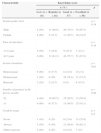Male or female homosexual, bisexual and transgender individuals (HBT) can be more exposed to viral hepatitis, but few studies worldwide have been conducted about viral hepatitis knowledge among HBT.1–5 The aim of this study was to evaluate viral hepatitis knowledge and potential risk of HBT and heterosexual individuals attending a Gay Pride Event.
A cross-sectional survey was carried out among a randomized sample of 121 Brazilian individuals attending to Gay Pride Event at Copacabana (Rio de Janeiro City) on November 2010. A questionnaire consisting of 23 items regarding demographic data, knowledge about viral hepatitis, sexual and risk factors behaviour was distributed to participants. Viral Hepatitis knowledge score was created based on the participants’ responses that were scored as follows: poor (0–2 correct answers), regular (3–4 correct answers), good (5–6 correct answers) and excellent (7–8 correct answers). The following variables were used to examine associations between knowledge of viral hepatitis and socio-demographic characteristics: age, sexual orientation, education years, sexual gender born, the number of partners in the last six months, and condom usage. All of the statistical analyses were made using GraphPad Instat version 3.0 for Windows. In this study, 42 women and 79 men at birth (median age±SD of 26±13.3 years) were included. Most of individuals reported as HBT (68.6%), had more than 12 years of education (74.4%), were earning among U$318.7–956.2 per month (50.4%), did not report previous HBV vaccination (61.2%), had only one sexual partner in the last six months (57%) and always used condom in sexual intercourse (57.8%).
Regarding risk factors, most people who reported having tattoos (84.6%) (p=0.01) and more than one sexual partner (82.7%) (p=0.006) belonged to HBT group. A large fraction of respondents presented good to excellent knowledge regarding viral hepatitis (78.5%) recognizing that viruses can be transmitted by sexual intercourse (86.8%), drug use (85.1%) or sharing of contaminated instruments (pliers, toothbrushes, razors, blades; 84.3%). However fewer individuals recognized that hepatitis A can be transmitted through oral-anal sex (56.2%) or through water and sewage or contaminated food (57.8%). Level of knowledge was higher among HBT (85.7%) as compared to heterosexual individuals (68.4%) (p=0.01) (Table 1).
Knowledge scores about viral hepatitis for the main characteristics of Brazilian Individuals attending Gay Pride Event in Copacabana Rio (n=121).
| Characteristic | Knowledge score | ||||
|---|---|---|---|---|---|
| n (%) | p | ||||
| Low (n=10) | Regular (n=16) | Good (n=37) | Excellent (n=58) | ||
| Sexual gender born | p=0.34 | ||||
| Male | 4 (40) | 11 (68.8) | 26 (70.3) | 38 (65.5) | |
| Female | 6 (60) | 5 (31.2) | 11 (29.7) | 20 (34.5) | |
| Time of education | p=0.14 | ||||
| >12 years | 4 (40) | 3 (18.8) | 9 (24.3) | 7 (12.1) | |
| ≤12 years | 6 (60) | 13 (81.2) | 28 (75.7) | 51 (87.9) | |
| Sexual orientation | p=0.01 | ||||
| Heterosexual | 6 (60) | 6 (37.5) | 8 (21.6) | 18 (31) | |
| Homosexual | 2 (20) | 8 (50) | 29 (78.4) | 31 (53.5) | |
| Bisexual | 2 (20) | 2 (12.5) | 0 (0) | 9 (15.5) | |
| Number of partners in the last six months | p=0.68 | ||||
| ≤1 | 4 (40) | 10 (62.5) | 22 (59.5) | 33 (56.9) | |
| >1 | 6 (60) | 6 (37.5) | 15 (40.5) | 25 (43.1) | |
| Condom usage | p=0.4 | ||||
| Never | 1 (10) | 4 (25) | 8 (21.6) | 15 (25.9) | |
| Always | 5 (50) | 8 (50) | 21 (56.8) | 36 (62.1) | |
| Others answers | 4 (40) | 4 (25) | 8 (21.6) | 7 (12) | |
The present study highlights the need to improve specific health messages in media campaigns carried out to the general population, since education campaigns about sexually transmitted diseases (STD) directed to the HBT population in the last years resulted in general good knowledge about viral hepatitis aspects in this group as compared to heterosexual individuals. Also, using a Gay Pride Event, this study was able to recruit HBT individuals who would have not necessarily been reached through more traditional recruiting techniques such as advertising in HBT-frequented venues.
Conflict of interestAll authors declare to have no conflict of interest.
Authors thank to Dr. Adilson José de Almeida for assistance in questionnaire development and Oswaldo Cruz Foundation (FIOCRUZ), FAPERJ and CNPq for financial support.






